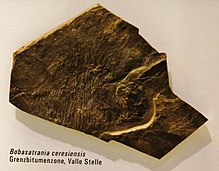Bobasatrania
This article has a list of references or other websites, but its sources are not clear because it does not have inline citations. (March 2024) |

Bobasatrania is an extinct genus of prehistoric bony fish that lived during the Triassic. It’s best known from beds of Changhsingian to Ladinian age. It is one of the most famous survivors of the Permian–Triassic extinction event. Bobasatrania originated during the Lopingian epoch.
Bobasatrania is part of the Bobasatraniiformes. The type species was named after Bobasatrana (near Ambilobe) in northeast Madagascar. The species is named after a river called the Mahavavy River.
Description
[change | change source]Bobasatrania had a unique diamond-shaped body. It had a forked tail. It did not exceed 30 cm in length. The pectoral fins were thin and elongated. It had large eyes and a small mouth.
Distribution
[change | change source]Fossils have been found in many places (Canada, France, Germany, Greenland, Italy, Madagascar, Spitsbergen, Pakistan, Switzerland, USA).
Classification
[change | change source]On 1932, Errol White discovered the type species, B. mahavavica. Bobasatrania, Dorypterus, Ebenaqua, and Ecrinesomus make up the Bobasatraniiformes, an extinct order of ray-finned fish.
Species
[change | change source]- †Bobasatrania antiqua Accordi, 1955
- †Bobasatrania canadensis Lambe, 1914
- †Bobasatrania ceresiensis Bürgin, 1992
- †Bobasatrania groenlandica Stensiö, 1932
- †Bobasatrania ladina Accordi, 1955
- †Bobasatrania mahavavica White, 1932 (type species)
- †Bobasatrania nathorsti Stensiö, 1921
- †Bobasatrania scutata Gervais, 1852
Synonyms
[change | change source]- †Haywardia Tanner, 1936
- †Lambeichthys Lehman, 1956
Image gallery
[change | change source]


Related pages
[change | change source]- Ohmdenia
- Dorypterus
- Platysomus
- Colobodus
- Chiasmocleis
- Microhylidae
- Euthynotus
- Protosphyraena
- Coccosteus
- Peipiaosteus
- Serenoichthys
- Pseudoasthenocormus
References
[change | change source]- Nielsen, Eigil. (1952). "A preliminary note on Bobasatrania groenlandica" (PDF). Meddelelser Fra Dansk Geologisk Forening.
- Böttcher, Ronald (2014). "Phyllodont tooth plates of Bobasatrania scutata (Gervais, 1852) (Actinoperygii, Bobasatraniiformes) from the Middle Triassic (Longobardian) Grenzbonebed of southern Germany and eastern France, with an overview of Triassic and Palaeozoic phyllodont tooth plates". Neues Jahrbuch für Geologie und Paläontologie, Abhandlungen.
- Russell, Loris S. (1951). "Bobasatrania? canadensis (Lambe), a giant chondrostean fish from the Rocky Mountains". Annual Report of the National Museum of Canada, Bulletin.
- Neuman, Andrew G. (2015). "Fishes from the Lower Triassic portion of the Sulphur Mountain Formation in Alberta, Canada: geological context and taxonomic composition". Canadian Journal of Earth Sciences.

Further reading
[change | change source]- Nielsen, Eigil. 1942. Studies on Triasslc Fishes from East Greenland. I. Glaucolepis and Boreosomus. Palaeozoologica Groenlandica. vol. I.
- Stensiö, E. A:EON, 1921. Triassic Fishes from Spitsbergen. Part I. Vienna.